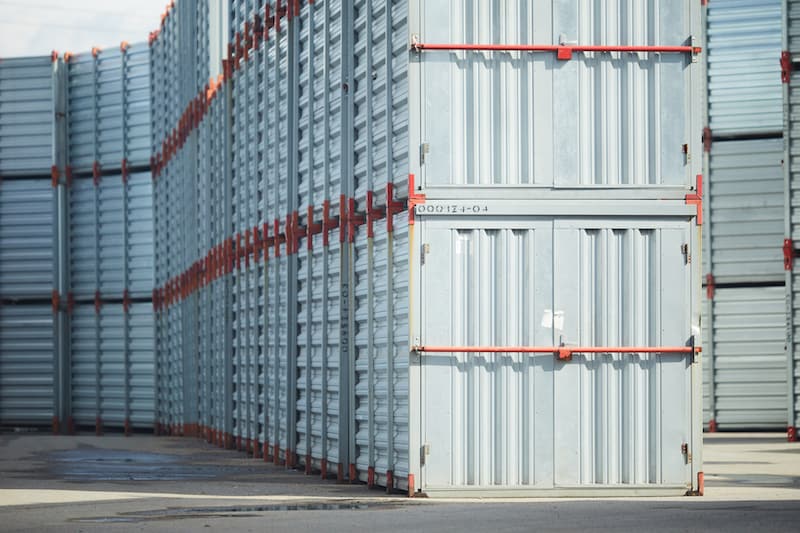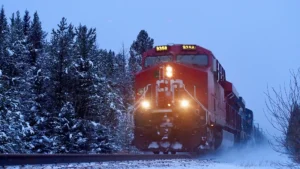This post was last updated on September 30th, 2022
The shipping container you choose for your business is important. You want to make sure that it’s the right size and that it’s going to protect your items during shipping. And by understanding the best way to stack items and seal containers, you can ensure your cargo arrives safely at its destination.
Here’s everything you need to know about shipping containers from us here at RailGateway.ca, your Canadian and cross-border shipping experts.
Shipping Container Selection Guide: Types, Features, Applications, Sizes, and Uses
When it comes to container shipping, there are a lot of options available. But which container is the right one for your needs? With our quick guide, you’ll be able to select the best container for your particular shipment based on factors like type, size, application, and more.
Standard Shipping Rail Container Sizes VS High Cube Containers

The Standardization of shipping containers
As rail traffic has evolved, it became a major challenge to standardize exterior dimensions, size, and capacity specifications to allow seamless transportation and movement of intermodal cargo.
Railroads have then developed standardized shipping containers that align with the common and ISO standards, in order to safely, efficiently, and cost-effectively ship rail cargo across Canada and generally speaking, across the world.
Two major shipping container sizes are in use nowadays:
- The ISO standard containers, are the ones set by the International Organization for Standardization thanks to the ISO 688 standard. They are the most common ones, used all over the world.
- The “High Cube Containers”, are based on a common USA/Canadian standard (used for instance by CN and CP rail companies), with slightly taller containers.
Dimensions differences between Standard and High Cubes containers
The major difference between the two rail containers is the height.
While ISO containers are 8’6″ or 2.59 meters tall, high cube containers have a height of 9’6″ or approximately 2.90 meters high.
This represents an increase of one foot or 0.305 meters over the standard rail container height. It allows businesses to fit more merchandise in the container’s interior while keeping the same length.
The Twenty-foot Equivalent Units (TEU) rail container specifications
Good to know: The rail container dimensions are also used to determine the rail container capacity. These are expressed in “Twenty-foot Equivalent Units” or TEUs.
Standard shipping containers are 20′ long (around 6.06 meters), 8’6″ high (around 2.59 meters), and 8′ wide (around 2.44 meters), which calculates to 38.29 square meters of rail cargo-carrying space. The 40′ long (12.19 meters) is another standard cargo container size.pace. The 40′ long (12.19 meters) is another standard common size.
Types of containers
Standard dry cargo containers are the most common type of containers used. They come in various sizes, from 20 feet (6 meters) to 40 feet (12 meters) long.
Reefer containers: These containers have built-in refrigeration units and are used for perishable shipments. They come in 20-foot and 40-foot sizes.
Flat rack containers are containers with no sides or roof and are used for oversized or oddly-shaped shipments. They come in 20-foot and 40-foot sizes.
Open top containers: These containers have no hard top, making them easy to load and unload from the top. They come in 20-foot and 40-foot sizes.
Sizes of containers
20-foot container: The most popular container size, a 20-footer is perfect for smaller shipments. It’s also the most manageable size since it’s the standard most shipping lines use.
40-foot container: A 40-foot container is ideal for larger shipments or consolidating multiple smaller shipments into one container.
53′ high cube Dry van container: This container is the largest on the market and can hold up to 25% more volume. What does this mean to you? 26 – 30 skids depending upon the actual dimensions of each skid.
At RailGateway, we specialize in 40-foot and 53-high cube dry containers. For more details, visit our container specifications page.
Features of containers
Doors: All containers have doors on one end, which can be opened for loading and unloading. Some container types (like reefers and open tops) may have doors on both ends.
Locking bars: Most containers have locking bars that can be used to secure the doors shut. This is important for preventing theft and keeping your shipment safe during transit.
Security features: Some shipping lines offer extra security features like GPS tracking and tamper-proof seals. These can be worth the extra cost if you’re shipping high-value items or sensitive materials.
Applications
Dry cargo: Standard dry cargo containers can be used for a wide variety of shipments, from clothes and electronics to furniture and machinery.
Refrigerated cargo: Reefer containers are perfect for perishable items like food, flowers, and pharmaceuticals.
Oversized cargo: Flat rack containers can accommodate oversized or oddly-shaped shipments that wouldn’t fit in a standard container.
Top-loading cargo: Open-top containers are convenient for top-loading shipments like lumber, steel coils, or vehicles.
What You Need to Know Before Packing a Shipping Container
Packing a container is not as simple as loading up your items and sending them on their way. There are a few things you need to know to properly pack and ship your container, from the right packing materials to use to the best way to stack your items.
Packing materials
Bubble wrap: Bubble wrap is perfect for protecting fragile items during shipping. It’s important to use a good quality bubble wrap that won’t pop easily.
Foam peanuts: Foam peanuts can be used in place of bubble wrap or as additional padding for delicate items. They’re also great for filling empty spaces in the container so that your items don’t break during transit.
Cardboard boxes: Cardboard boxes are great for organizing and keeping your items safe during shipping. It’s important to use sturdy boxes that won’t collapse under the weight of your shipment.
Packing tape: Packing tape is essential for sealing up your boxes and securing them in the container. Make sure to use good-quality tape that won’t come undone easily.
Labeling
It’s important to label all of your boxes so that the receiving party knows what’s inside. This will make unpacking easier and help to prevent any damages or losses. Be sure to include a detailed description of the contents, as well as your contact information in case there are any problems with the shipment.
How to Properly Pack and Ship ISO Containers
Now that you’ve selected the right container for your shipment, it’s time to start packing. Here are a few things you should keep in mind in order to ensure that everything arrives safely and in one piece.
Choose the right packing materials. For fragile items, use padding like bubble wrap or foam peanuts. For heavy items, use wooden pallets to distribute the weight evenly.
The Best Way to Stack Items in a Cargo Container
Stack items carefully. Make sure that heavier items are on the bottom and lighter items are on top. Use dunnage (wooden boards or metal bars) to secure stacked items and prevent shifting during transit.
How to Seal Intermodal Containers
Once your container is packed, seal the doors shut with locking bars or tamper-proof seals. Label the container with your contact information and the destination address.
Shipping Overseas
If you’re shipping a container overseas, there are a few additional things you need to do in order to ensure that everything goes smoothly.
First, you’ll need to obtain a bill of lading from the shipping company. This document will list the contents of your shipment and act as a contract between you and the shipper.
You’ll also need to fill out a customs declaration form. This form will list the value of your shipment and any applicable taxes or duties.
Finally, make sure to check with the destination country’s customs department to see if there are any special requirements for importing goods.
Packing and shipping a container doesn’t have to be complicated. With a little preparation and the right materials, you can safely ship your items to their destination. Just remember to choose the right container, pack carefully, and label everything clearly. By following these simple tips, you can be sure that your container will arrive safe and sound.
Looking to save on your Canadian intermodal transportation costs? At RailGateway, we have over 40 years of experience and can help you save time and money. Contact us today to request your rail quote.
For more information about container shipping, check out our posts:
10 Types of Intermodal Cargo You Can Ship in Containers
Container Bites: Interesting Intermodal Container Stats and Tid Bits
The Intermodal Container: Everything You Need to Know About Containerisation!






